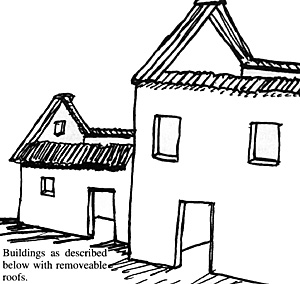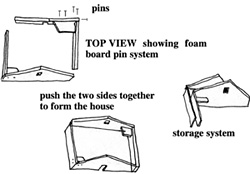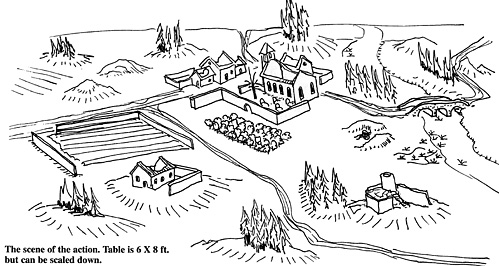Combat Rules
These are relatively easy to use rules. The card system allows all the players to watch the action and to plan their moves for when their card is drawn. There is a great deal of suspense each turn as players wait for events to unfold. Only American football has simultaneous turns, called downs, in other games once play starts, time is wobbly and momentum ebbs and flows, not everyone gets to the ball or starts to run at the same time. That's the way it is in combat and most sports. Simultaneous movement is fantasy, everybody starts at a different time in real life.
Sequence of events: A card is created for each hero figure which includes his name, basic function value and other information if desired such as wounds. The cards are shuffled and then turned over one at a time. When a figure's card is drawn the owning player rolls a D6 and adds that number to the base functions value, the figure then performs activities as permitted, up to its total functions as the owning player desires. All the hero's attached figures have the same number of functions and must be within 10 inches of the "Hero" figure at the end of the move.
Figures more than 10 inches away from the hero and out of line of sight are removed from play as being lost. The next card is drawn until all cards have been drawn and all figures have had a chance to perform or react. Then the cards are shuffled and the next turn starts.
The referee can add cards to the deck that will spice up the game, for example; "the next card drawn trips and losses half the functions rolled" or other cleaver cards. Only put one of these cards in the deck at a time or you can have a second deck called "bad cards" and put a "draw a Bad Card" card in with the player cards and have the next player drawn pull the card before he starts movement. Remember that you can put some good cards in the deck because a good card is bad for everyone else.
Functions: each figure has a predetermined number of functions that are listed on his card. This base function will be between 0-3, to this he/she will add a D6 roll. The player expends functions performing various tasks per the chart below:
| Actions | Functions Expended | |
|---|---|---|
| Move two inches | 1 | |
| Crawl one inch | 2 | |
| Throw Weapon (Knife or Hatchet) | 2 | |
| Load Canon | 16 (4 figs 4 functions) | |
| Stand Up | 2 | |
| Fire weapon | 1 | |
| Aims weapon | 3 | |
| Loads musket or pistol | 4 | |
| Loads rifle | 6 | |
| Climbs wall or into window | 2 | |
| Enters building or door | 2 | |
| Wounded figures will double all the above functions costs. | ||
Hand-to-hand Combat
Figures that move into base contact conduct hand to hand combat. Each rolls a D6 and adds all modifiers. The high roll wins and the loser checks the result by looking at the difference on the hit result table. Example, if two figures roll D6 against each other and one rolls a five plus charging for a total of seven and the other rolls four plus bayonet armed for five then the difference is two; the loser is wounded. Losers always take a morale check if they pass they all run away two D6 inches.
Hand to hand modifiers
- Charging +2
Bayonet armed +1
Sword armed +1
Wounded -3
Officer +1
Elite/NCO +1
Mounted +4
Second in time in hand to hand -2
Unarmed -1
Hero (player) +2
Fire Combat
Fire combat is part of each player's possible actions when his/her card is drawn. There is no fire phase per-se. Fire is line of sight only and the target must be in range. Simply measure the range to the target in inches and roll the die indicated on the chart below, multiplying or dividing as indicated. Add any modifiers from the list below to the die roll.
Small arms modifiers
- Target moved -2
Aimed shot +2
Hero shooting +1
Target in building or cover -2
If the modified D20 roll is higher than the range in inches you have a hit and the target rolls on the To Hit Table above. A (20) twenty roll is always a hit and a roll of one (1) is always a miss and a weapons malfunction for the rest of the game.
| RANGES | ||
|---|---|---|
| Weapon | Range | Dice |
| Musket | 20in. | D20 |
| Rifle | 40in. | 2xD20 |
| Pistol | 10in. | D20/2 |
Mark shooters with a cap or ring on the musket to indicate the weapon is unloaded. Remove the indicator after the player spends the 'functions' to reload the weapon above.
Hit Table
Figures hit by fire or in hand to hand roll on the hit table below.:
| D6 Roll | Result |
|---|---|
| 1 | No effect |
| 2-3 | Wounded/ double function costs |
| 4 | Dying, roll D6 for turns left. |
| 5-6 | Killed |
Artillery Fire
Artillery is line of sight and is of two types: cannister and ball. Cannister is fired in an expanding cone and will force a to-hit-roll on every figure in the cone of expanding canister.
Reloading the gun takes sixteen functions which can be divided between up to four figures thus spending four functions each.
| ARTILLERY FIRE | |||
|---|---|---|---|
| Weapon | Canister Zone Width | d6 To Hit | |
| 4pdr | 8pdr | ||
| 1-4" | 1" | 2" | 1-5 |
| 4-8" | 2" | 4" | 1-5 |
| 8-12" | 4" | 8" | 1-4 |
| 12-16" | 8" | 12" | 1-3 |
| 16-20" | 10" | 12" | 1-2 |
| 20-24" | 10" | 14" | 1 |
| 24-30" | 12" | 16" | 1 |
| 1-100" | Ball | 1* | |
| *If unit is hit check morale. | |||
Morale
Morale is difficult to simulate at the skirmish level. Basically, any time a unit (all the figures under a player's control with the hero figure) take a number of hits in a single turn equal to 20% of its strengh it must check morale. It does so by taking a die roll on a D6. If the unit rolls a six it must scatter to cover. Roll three D6 for each figure and move that figure that number of inches to a place of refuge/cover or just away from the source of hits.
Any figures that end up outside of 10 inches and out of line of sight of the Hero are lost. Units that lose a hand-to-hand after two rounds also scatter in the same way. The hero figure also rolls for the scatter but his roll will be the last.
Building the Terrain
 Houses: Foam board is an excellent medium for buildings. I recommend that you assemble buildings that are to scale for the figures. Do this by making corners of buildings and keeping the roof open in order to ease the play and movement of figures. By moving the corners together you have the house. See the example below. Cut the foam board with a mat knife and make mirror sides. Make the corner sets large more than eight inches high and ten inches long. You can and should vary the building sizes just make sure you have mirrored corner sets. Cut windows and doors large enough to fit the figures.
Houses: Foam board is an excellent medium for buildings. I recommend that you assemble buildings that are to scale for the figures. Do this by making corners of buildings and keeping the roof open in order to ease the play and movement of figures. By moving the corners together you have the house. See the example below. Cut the foam board with a mat knife and make mirror sides. Make the corner sets large more than eight inches high and ten inches long. You can and should vary the building sizes just make sure you have mirrored corner sets. Cut windows and doors large enough to fit the figures.
Pin the pieces together and glue them with Elmer's Glue. Spread the glue over the edges and put paper towel pieces on the glue to reinforce the corners. Also, use some square scraps of foam board to reinforce the corner and pin and glue these as well. After it drys remove the pins. You can use a thin coat of plaster of paris or Durham Puddy to give the walls texture. Then use diluted water-based paint to color the walls. The corrugated wrappers for light bulbs make great tile roof material.
 Spray paint the wrappers and cut them in strips one to two inches wide and glue them to the top edges of the walls. This will give a great look to the building and still allow players to reach in. The reason for the corner sets has to do with storage; the sets can be placed next to each other in an overlap system thus reducing the storage space significantly. See the drawings.
Spray paint the wrappers and cut them in strips one to two inches wide and glue them to the top edges of the walls. This will give a great look to the building and still allow players to reach in. The reason for the corner sets has to do with storage; the sets can be placed next to each other in an overlap system thus reducing the storage space significantly. See the drawings.
I hope you will consider this type of game, it requires very few figures and you can have fun finding odd sorts of items to include in the game. A number of manufacturers produce suitable figures. Good gaming!!
Map

More Sharpe's Mess
-
Sharpe's Mess: Introduction
Sharpe's Mess: Player Briefings and Missions
Sharpe's Mess: Combat Rules
Back to Table of Contents -- Courier #76
To Courier List of Issues
To MagWeb Master Magazine List
© Copyright 1999 by The Courier Publishing Company.
This article appears in MagWeb (Magazine Web) on the Internet World Wide Web.
Other military history articles and gaming articles are available at http://www.magweb.com